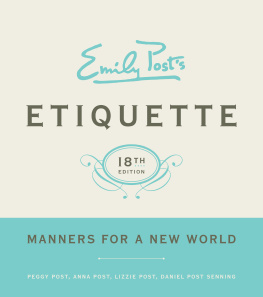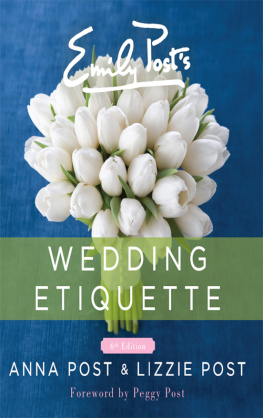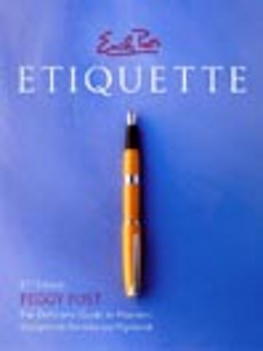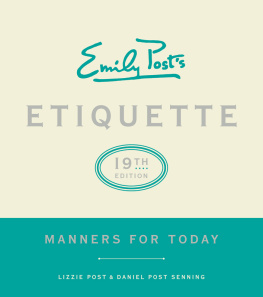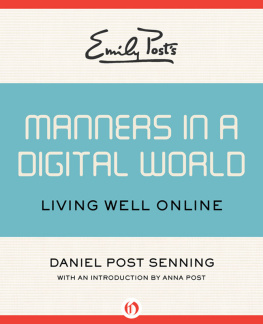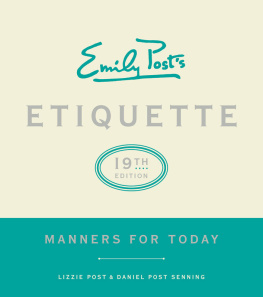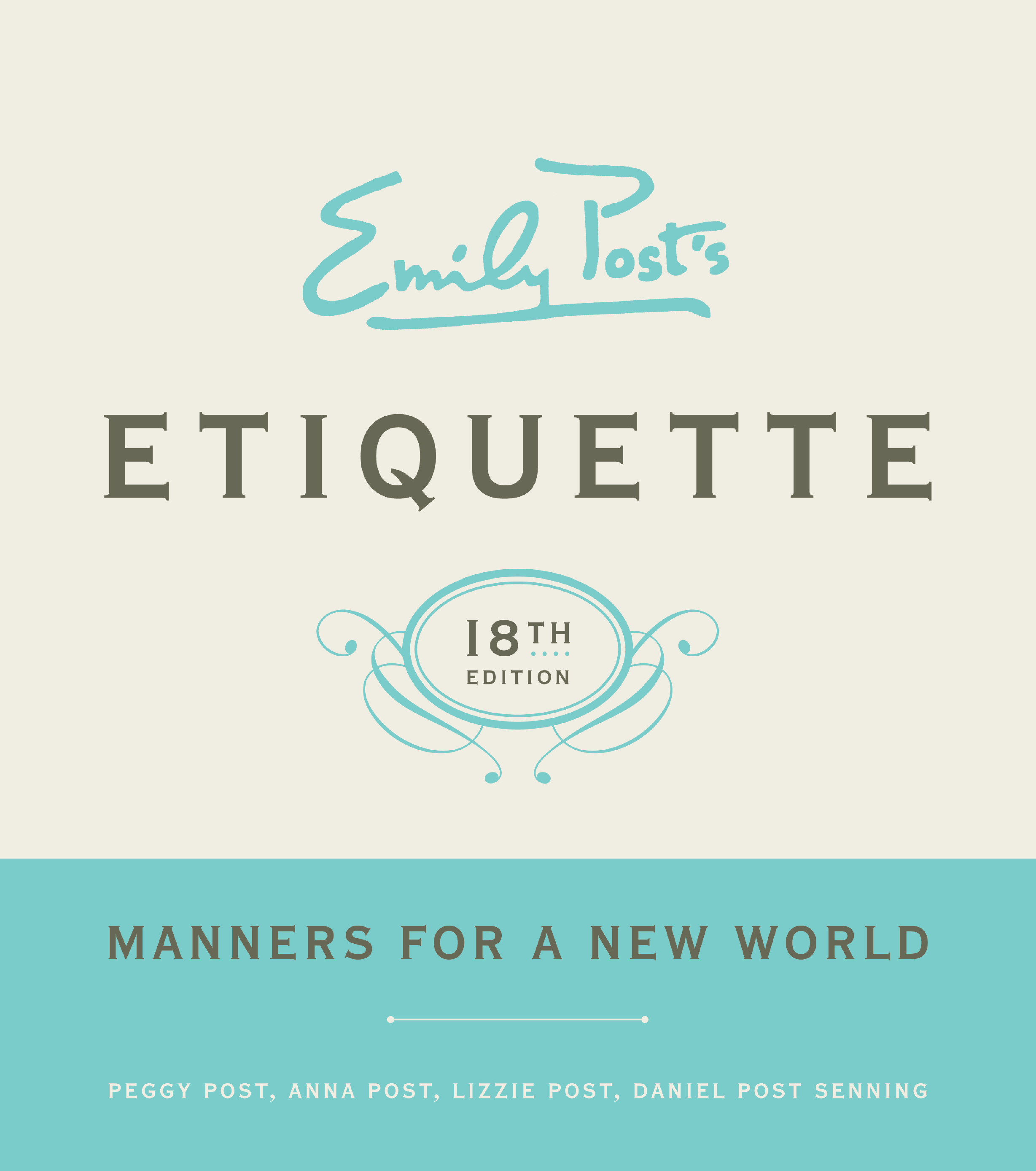

With love and gratitude we dedicate the 18th edition to all of our mothers who have made this book possible, particularly Elizabeth Lindley Post (19202010), known to us simply and affectionately as Mud.
Contents
w ith new authors and new voices, Emily Posts legacy continues! I am very proud to introduce the fourth generationAnna Post, Daniel Post Senning, and Lizzie Postas principal authors and spokespersons for The Emily Post Institute. Researching and producing the 18th edition of Emily Posts Etiquette with them has been an exciting, family-wide team effort.
Peggy Post
How do you give Emily Post a manners makeover? We started with a fresh, user-friendly, engaging design format and a more conversational tone to our writing. More challenging was identifying what has changed since the publication of the 17th edition in 2004. We want Etiquette to speak to traditional etiquette fans as well as to those new to Emily Poston the one hand reaffirming the values and manners of previous generations, while at the same time promoting the best practices of current society. We know that mannersthe particular ways in which we show respect and considerationchange over time. Long gone are the 1st edition chaperone and the 12th edition ashtrays at the dinner table and white gloves; they have been replaced by topics that have relevance to the daily lives of most Americans today, such as managing new communications forums and devices, having confidence at work, and navigating new family structures and dynamics.
We restructured Etiquette to reflect the different worlds we inhabitour homes, communities, social circles, and workplaces. In addition, we examined the manners and considerations essential to building strong families, friendships, and positive home environments, raising courteous and respectful children, and covering all of lifes stagesfrom birth or adoption, childhood, and adolescence to college, work, marriage, family, retirement, illness, and death. Often-accessed practical information, such as forms of address and attire charts, is grouped together in a ready-reference resource guide.
Thinking to the future, we designed the 18th edition to be fully integrated with The Emily Post Institutes website, emilypost.com. The structure of the book matches the architecture of the site, with landing pages for each book section and subpages for each chapter. Readers will know exactly where to go on our site to get further information or the latest information on any subject from social networking to wearing a hat. Simply type in the url (no spaces, please) found at the bottom of each page into your browser and click. Our site is also home to the Etipedia, our searchable database that puts Emily Post etiquette information articles, interviews, and q&asat your fingertips.
In our fast-paced, stressed-out world, is etiquette still relevant? We say yes: Etiquette is a topic of national conversation. At the Emily Post Institute, its a rare day when were not fielding media interviews on topics ranging from whats appropriate to wear to the White House, what impact a royal wedding has on the everyday bride, whether its okay to unfriend your ex but not his friends, guidelines for polite smartphone use, and how to handle dinner guests myriad dietary restrictions.
You, our readers, are also an essential part of those conversations. We take your questions and opinions seriously. What was once a one-on-one question and answer service has evolved into our blog, The Etiquette Daily, accessible through our website or at etiquettedaily.com. Youll find not only commentary by Emily Post authors, but also the Question of the Day, our forum where we can share ideas and solutions in real time. It is monitored by Emily Post staff who chime in from time to time, but its real value is your voice. We invite you to join us there.
As much as etiquette is about weddings and table settings and forms of address, at its most essential its about interactions and relationships and communication. Knowing which fork to use will give you social confidence, but applying the principles of etiquetteconsideration, respect, and honestywill enhance every interaction. Its now not just possible but commonplace to connect with dozens, hundreds, even thousands of people at once through social networks, blogs, tweets, texts, and emails. Video conferencing has left the office and come home to the living room. This communications revolution is truly remarkable and wonderful and offers so many beneficial opportunities, not just to connect offices and families but to give each individual a voice. With this opportunity to voice our opinions and share our ideas comes the responsibility to do so civilly. Irresponsible rants, inflammatory language, and defamatory remarks are divisive and polarizing, and only serve to heighten anxiety and sow distrust. Used wisely, these remarkable forums can be powerful community-building tools, fostering civil discourse, cooperation, and positive outcomes. As our country faces the challenges of an increasingly complex and diverse world, civility becomes all the more critical to our countrys success.
It is our fervent hope that you will turn to us not just for advice on planning your wedding or setting your dinner table, but as a trusted companion and guide, wherever your lifes journey takes you.
We wish you all the best.
Sincerely,
Peggy Post
Anna L. Post
Lizzie Post
Daniel Post Senning
Spring 2011

P ART I
everyday manners
CHAPTER 1
guidelines for living
s cientific and medical advancements have made life easier over the years, but the stresses and strains that come with population density, technological advancements, 24/7 news and entertainment media, and a redefinition of the family have resulted in a whole new set of challenges. People behave no worse than they used to, but with the pressures of modern life it can be more difficult to stay civil. In this fast-paced society with its multiple demands, its all the more important to be intentional about using common courtesies in our everyday interactions.
Its true that we take a more casual approach to dressing, communicating, and entertaining. But casualness, or informality, doesnt necessarily equate to rudeness. Its just as easy to be polite when wearing jeans to a party as when wearing long white gloves to a ball.
Manners by their very nature adapt to the times. While todays manners may be more situational, tailored to particular circumstances and the expectations of those around us, they remain a combination of common sense, generosity of spirit, and a few specific rules that help us interact thoughtfully. And as fluid as manners are, they all rest on the same fundamental principles: respect, consideration, and honesty.
Respect. Respecting other people means recognizing their value as human beings, regardless of their background, race, or creed. Its demonstrated in all your day-to-day relationsrefraining from demeaning others for their ideas and opinions, refusing to laugh at racist or sexist jokes, putting prejudices aside, and staying open-minded. We show respect not just by what we refrain from doing but also by intentional acts, such as being on time, dressing appropriately, or giving our full attention to the person or people were with.
Next page
